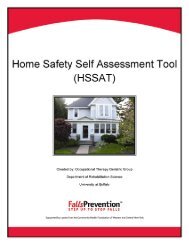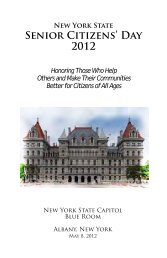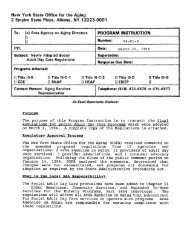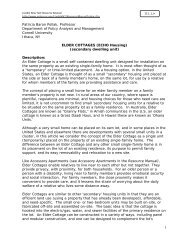Sustaining Informal Caregivers - New York State Office for the Aging
Sustaining Informal Caregivers - New York State Office for the Aging
Sustaining Informal Caregivers - New York State Office for the Aging
You also want an ePaper? Increase the reach of your titles
YUMPU automatically turns print PDFs into web optimized ePapers that Google loves.
Additional statements made by caregivers about <strong>the</strong> impacts of services are included in<br />
Appendix B, “<strong>Caregivers</strong> Comments: Impacts of Services on <strong>Caregivers</strong>’ Lives.”<br />
Additional Help and In<strong>for</strong>mation that Would Be Valuable<br />
While <strong>the</strong> majority of caregivers rated <strong>the</strong> services <strong>the</strong>y received as ei<strong>the</strong>r excellent or very good<br />
and are likely to recommend those services to a friend, <strong>the</strong>y also indicated that <strong>the</strong>y would like to<br />
have additional help. The survey asked respondents what additional or new kinds of services or<br />
help would be valuable to <strong>the</strong>m. The top two areas indicated by caregivers are: tax credits or tax<br />
breaks (71 percent) and respite care (63 percent).<br />
• Tax credits or tax breaks: Caregiver research literature reported that caregivers often<br />
help pay <strong>for</strong> health care, medication, and long term care services, in addition to covering<br />
<strong>the</strong> costs of food, home maintenance, and transportation (Evercare, 2007). Close to three<br />
quarters of caregivers who responded to <strong>the</strong> survey identified tax credits or tax breaks as<br />
additional help <strong>the</strong>y would like to obtain, which indicates that caregivers are in need of<br />
financial assistance to address <strong>the</strong> cost burdens <strong>the</strong>y shoulder, in addition to <strong>the</strong> emotional<br />
and time costs of <strong>the</strong>ir caregiving responsibilities.<br />
• Respite care: Ano<strong>the</strong>r key area <strong>for</strong> which caregivers would like additional help is respite<br />
care. Respite is a service that provides temporary relief to caregivers so <strong>the</strong>y have time to<br />
attend to <strong>the</strong>ir family’s needs, participate in a support group, attend a class to learn<br />
caregiving skills, or simply have time <strong>for</strong> <strong>the</strong>mselves. Past research suggests that respite<br />
care can relieve burdens of caregiving, prevent “burnout,” and enable families to continue<br />
to care <strong>for</strong> loved ones.<br />
O<strong>the</strong>r services that caregivers identified as being valuable to <strong>the</strong>m include help with: financial<br />
assistance to pay <strong>for</strong> services, housekeeping, transportation, personal care, adult day services,<br />
meal preparation, getting o<strong>the</strong>r family members involved, and shopping.<br />
In terms of additional or new kinds of in<strong>for</strong>mation that would be valuable to caregivers, <strong>the</strong> top<br />
two types of in<strong>for</strong>mation identified in <strong>the</strong> survey are: in<strong>for</strong>mation/help in working with <strong>for</strong>mal<br />
agencies (88 percent) and in<strong>for</strong>mation about changes in laws (87 percent).<br />
• In<strong>for</strong>mation about how to work with <strong>for</strong>mal agencies: Because caregivers'<br />
responsibilities expand far beyond carrying out daily living tasks and often include<br />
identifying, coordinating and arranging <strong>for</strong> home and community-based long term care<br />
<strong>for</strong> <strong>the</strong>ir loved ones, <strong>the</strong>y need in<strong>for</strong>mation on how to navigate <strong>the</strong> complex health and<br />
long term care system and need unbiased and accurate in<strong>for</strong>mation on available long term<br />
care services and supports within <strong>the</strong>ir community. The NY Connects: Choices <strong>for</strong><br />
Long Term Care program can address this need as it is designed to help individuals<br />
identify and access appropriate levels and types of services. However, <strong>the</strong>re is a need <strong>for</strong><br />
more public education and marketing of NY Connects in order <strong>for</strong> caregivers to become<br />
more aware of its availability.<br />
16








